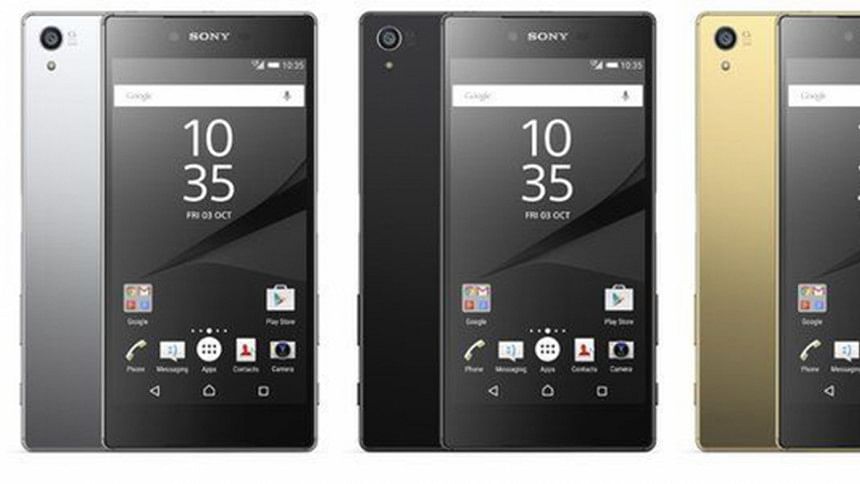Sony Phone is first to have 4K screen

Sony has unveiled the first smartphone to feature a 4K-resolution screen.
It means the Xperia Z5 Premium can both capture video in "ultra-high definition" quality and then play it back on its 5.5in (14cm) display without downgrading the footage.
All the firm's Z5 handsets also feature a new camera module - the first time the part has been completely overhauled since 2013's original Z1 handset.
Sony's mobile division loses money, but its camera components are profitable.
Apple, Samsung, Xiaomi and Huawei are among rival handset-makers to have used earlier generations of the Japanese company's photo-capture technologies.
However, Sony said the 23 megapixel sensor involved was being kept as an "exclusive" to its own devices for the time being.
The company recently forecast its handset business would rack up a 60bn yen ($500m; £326m) operating loss in its current financial year.
But it forecast its image sensor wing - which also makes parts for bigger cameras - would generate 580bn yen ($4.8bn; £3.1bn) of sales over the same period.
Sony hopes its mobile phones will become profitable again in 2016, but its chief executive told the BBC in March that there was "no guarantee" it would still be making handsets in five years time if a turnaround failed to happen.
Big battery
Sony unveiled its new Android-powered handsets at Berlin's Ifa tech show.
The company acknowledged that there was still a limited amount of professional content available in 4K - which provides about four times the number of pixels as 1080p high definition video.
But it said the Z5 Premium would upscale videos streamed from YouTube and Netflix to take advantage of the display.
One of the big concerns about high-definition screens is that they run down batteries more quickly.
Sony says its use of a "high capacity" 3,430 mAh battery and memory-on-display tech - which allows a static image to remain on show without requiring extra processing power - should mean the handset lasts for "up to two days" between charges.
But one expert still had concerns.
"I really doubt it will last two days if you watch a 4K movie on the device," said Francisco Jeronimo from the tech research company IDC.
"There's not really a need for a 4K display from a consumers point-of-view.
"But this is really about offering something outstanding that its competitors can't provide today and raising brand awareness."
Low light
Sony's new camera module benefits from the introduction of a "closed-loop actuator" stabilisation system.
This adds a position sensor to the part, which is used to detect small disturbances and then compensate for them by making the lens move up and down in its housing in a related fashion.
As a result, it should be able to film less jerky video clips.
The addition of a sixth camera element causes more light to fall on to the sensor, which should aid low-light photography.
Sony has also added more "phase-detection" pixels to the sensor. These are used to speed up autofocus and now cover the complete frame rather than just its central area.
The result is that the sensor can react more quickly to action occurring on the edge of shot.
The company says this and other improvements mean the camera is capable of refocusing in 0.03 seconds, making it "the fastest autofocus in a smartphone".
However, Jeronimo doubts whether most users will appreciate the innovations.
"The big question is whether consumers will perceive the added quality when they take a picture," he said.
"I took a few pictures with an iPhone 6 and the new Sony Z5 Premium in low light, and to be honest the quality was very similar.
"Once you get to a certain level, it becomes very difficult to notice the difference unless you print the picture in a large size, and that's true for most of the top-end handsets."
Nonetheless, he added, the sensor had a good chance of being adopted by other smartphone companies if it proved superior in independent tests to alternatives.
Its competition will include Samsung's recently announced S5K3P3 sensor, which has a lower resolution of 16 megapixels but has been designed to be very thin to offer "minimal camera protrusion" from slimline handsets.
Fruit phone
Other companies that launched new smartphones at Ifa on Wednesday included:
Huawei - its Mate S features a "force touch" screen that can determine different levels of pressure, in a similar fashion to the Apple Watch. The Chinese firm showed off the feature by using it to weigh an orange
Acer - its Predator 6 is targeted at hardcore gamers. The handset has four gigabytes of RAM memory, four speakers and a ten-core processor, which gives the phone more scope to ramp up its computational power when necessary
Asus - its Zenfone Zoom features a 3x optical zoom camera, meaning that owners will be able to get close-up shots without sacrificing image resolution

 For all latest news, follow The Daily Star's Google News channel.
For all latest news, follow The Daily Star's Google News channel. 



Comments